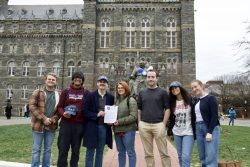February brought a flood of e-mails and letters from the administration to faculty, students and parents about the state of safety at Georgetown. When the federal government raised the “terror alert” to orange, the University responded by overloading students with unnecessary information and justifications of its policy since Sept. 11, 2001. The University should spend less time praising what it has done over the past year and a half, and focus its resources on practical measures that will directly affect students.
The centerpiece of the University’s emergency preparedness since Sept. 2001 has been the establishment of both the Emergency Response Team and the position of Senior Vice President and Chief Administrative Officer, which has been held by Spiros Dimolitsas since last summer. The ERT, which reports to Dimolitsas, is composed of teams that specialize in areas like safety or communication.
The University claims that the team has formed various plans for rapid internal coordination and access to local and federal resources, but material accomplishments for students are few. The ERT’s claim of hiring a security firm to ensure 24-hour manned security is misleading. Guards who work the night shifts in the residence halls were hired as a result of student protests to the lockdown policy. The current policy is a result of GUSA—it was not an ERT initiative.
University President John J. DeGioia sent a letter to parents Feb. 19 emphasizing the precautions the University has taken. Part of the University’s plan includes conducting evacuation drills, in which DeGioia says many students have participated. However, Resident Assistants confirmed that none of the residence halls-New South, Village C East and West, Harbin, Darnall, Copley and LXR-have had any evacuation drills this academic year. Regardless, few projected emergencies in D.C. due to the increased terror alert would require students to evacuate classroom buildings or residence halls.
Another measure that the University emphasizes is the closure of campus entrances. In an e-mail to the University community on Feb. 13, Dimolitsas stated that only two of the four entrances to campus, Reservoir Road and Canal Road, are open during off-hours. However only the front gates are closed due to security; the Prospect Street entrance is closed because of construction and students have been notified that it will reopen before graduation.
As shown by recent on-campus events, threats to students are most likely posed by other students and members of the community, in the form of theft, mugging and assault. But the threats the University is more concerned with are unlikely to occur and difficult to prevent. The University claims to have evacuation plans for various scenarios, but students have not been made aware of them, let alone had the opportunity to practice them. Because the ability to communicate plans during a disaster could be limited, students need to be familiar with these plans beforehand.
Georgetown students chose to attend a university in Washington, D.C.; they are aware of the risks. While students have the right to appropriate evacuation and communication plans, they must also know that the University cannot protect them from an emergency in the District. The University must focus on daily security on-campus, an area where campus resources can be used effectively. If anything regarding an “orange alert” needs to be e-mailed to students, it should be concrete plans for different scenarios, not simple cautionary phrases and well-known links to the Red Cross website.




